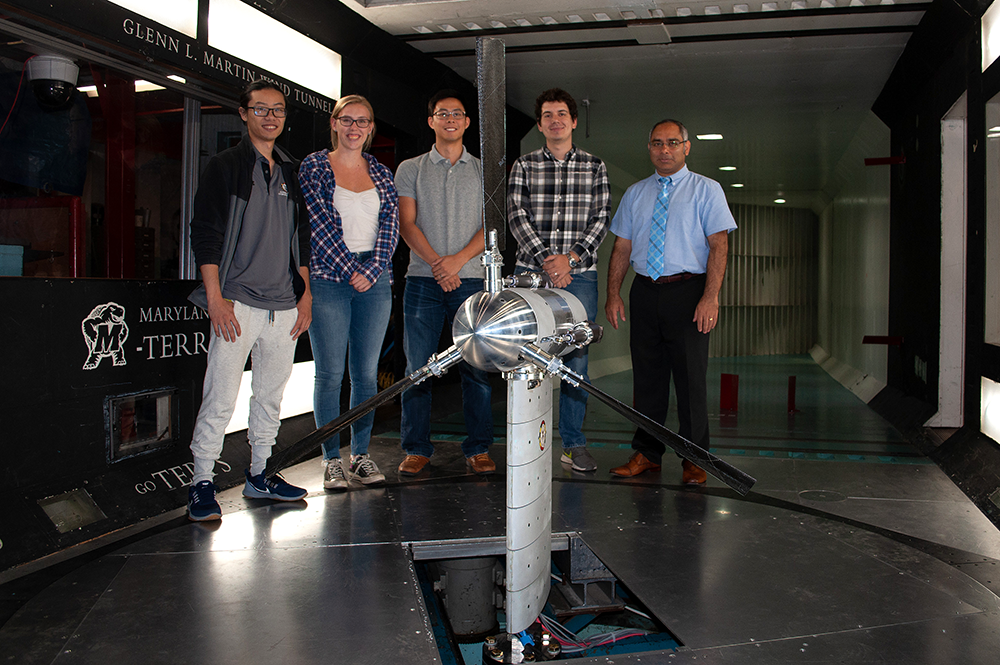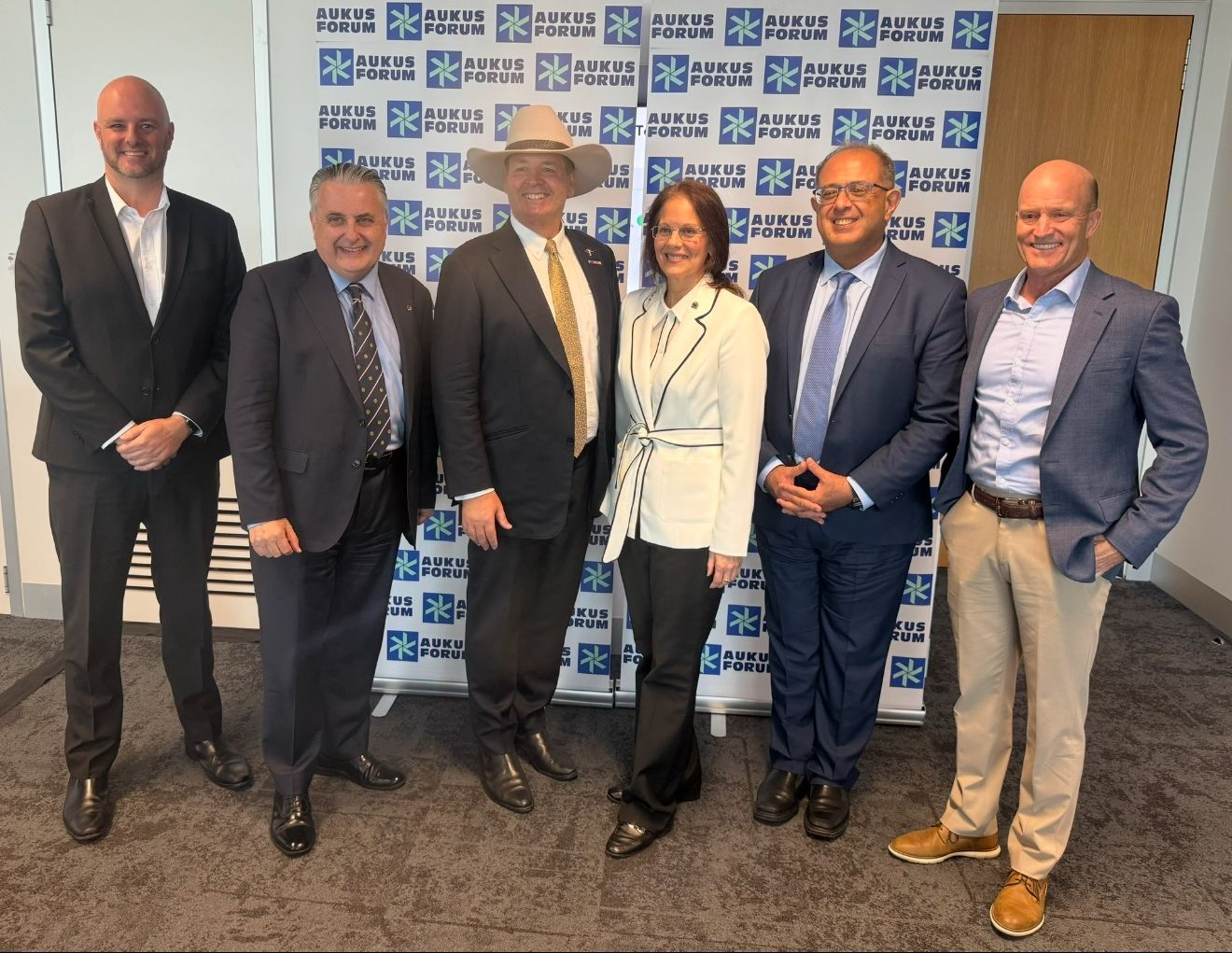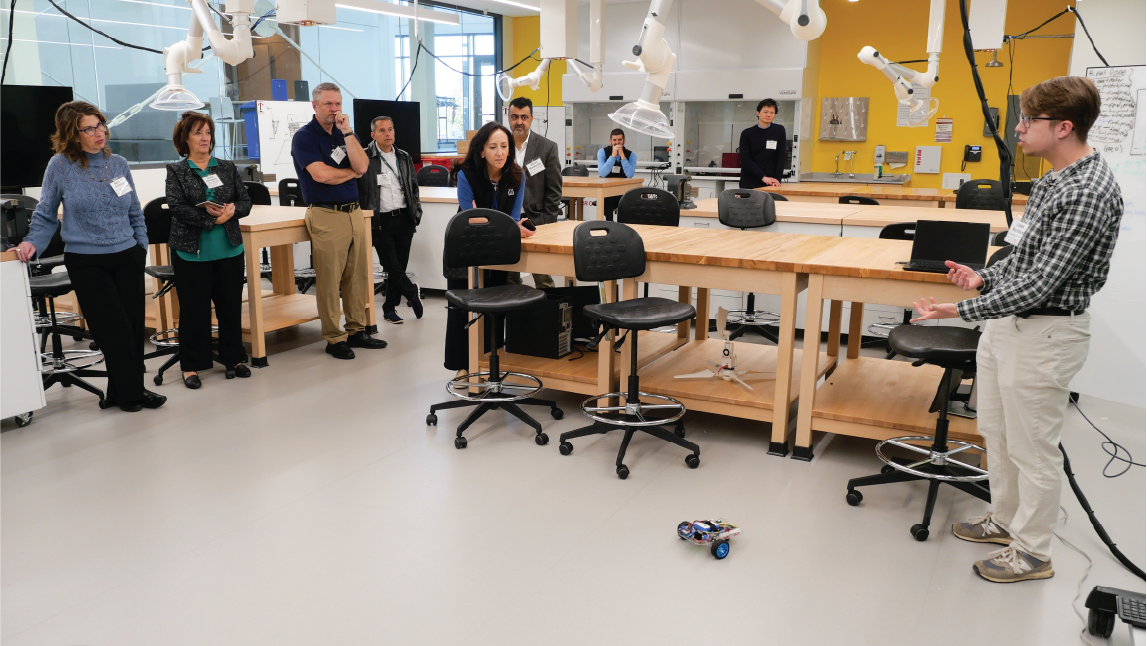News Story
Envisioning the Future of Urban Transportation

Dr. Anubhav Datta (far right) and students with the Maryland Tiltrotor Rig (MTR) inside of the Glenn L. Martin Wind Tunnel. The MTR is used to facilitate eVTOL and other research.
Could lightweight electric vertical takeoff and landing aircraft be a solution for urban congestion?
Growing urbanization around the globe is creating increasingly difficult challenges in areas of transportation and energy, but engineers at the University of Maryland (UMD) think there are solutions in the promise of electric vertical takeoff and landing (eVTOL) aircraft.
Just a decade ago, the idea of air taxis and cityscapes equipped with “verti-port” stations may have seemed like the latest science fiction, but with the technical advances and commercial success of electric vehicles, eyes are turning to the sky to see how similar ideas of electric power and propulsion could create a new generation of lightweight air vehicles capable of moving people quietly, safely, and efficiently in dense urban environments.
“eVTOL has many advantages over traditional helicopters,” explains Anubhav Datta, an associate professor in UMD’s A. James Clark School of Engineering. “They don’t cause the pollution of traditional engines, have no engine noise, require fewer mechanical parts, and depending on the design could be easier to fly and more responsive to autonomy.”
While eVTOL technology is in its infancy, Datta has been involved from the start. He published the first peer-reviewed journal article demonstrating the viability of eVTOL by presenting conceptual designs for three all-electric options for a manned ultralight utility helicopter, and anticipating growth of the field. Since then, he has been instrumental in spearheading efforts to expand basic research in eVTOL, create pools of technical knowledge, and develop multidisciplinary education and outreach programs.
At Maryland, Datta and his graduate students are pursuing several projects addressing some of the principal barriers that prevent eVTOL from becoming a day-to-day reality.
One major barrier to eVTOL success is developing lightweight on-board electrical energy storage systems that would allow these aircraft to fly for longer periods with adequate reserves. According to Datta, lithium-ion batteries built for consumer electronics and automobiles are too low-energy to be a long-term solution. Batteries must be built to meet VTOL requirements or alternative sources of power explored, such as the work of Ph.D. student Emily Fisler, who is trying to quantify these requirements and explore more advanced chemistries for future batteries.
Datta, along with students Wanyi Ng and Mrinal Patil, are also exploring the application of hydrogen in fuel cells as a renewable and clean energy source. Hydrogen gas can store four to five times as much energy as current batteries, but the high power fuel stacks are heavy—so Datta’s team is looking at ways to maximize the energy benefits of hydrogen by using supplemental batteries to boost output during high-power loads, such as takeoff and landing.
Since 2017, UMD’s Department of Aerospace Engineering has won two multi-year research tasks on eVTOL funded jointly by the U.S. Army, NASA, and the U.S. Navy. As part of this work, Ph.D. student Brent Mills has built a unique hybrid-electric engine—capable of powering a scaled-down 50-pound VTOL aircraft to test and acquire data on electro-aero-mechanical behavior of the engine. Aircraft designers of the future can use this data in conceptualizing and building vehicles.
A key advantage of electric drives is that they do not require heavy, interconnecting mechanical shafts to drive more than one rotor. While multiple rotors are less efficient, they make an aircraft more stable and maneuverable, which could possibly reduce training times for future pilots and make them safer to operate in urban environments. In addition, being easier to control makes them more receptive to autonomous operation.
According to Datta, one critical advantage to UMD’s eVTOL research is the university’s historic Glenn L. Martin Wind Tunnel. Constructed in 1949, it is one of only a few tunnels its size on a university campus. This facility enables them to acquire truth-data from direct observation that is critical to the safe design of advanced rotorcraft, yet far beyond what the best computational tools can predict. Special-purpose rigs are needed to carry out model tests in the tunnel.
One such rig is the Maryland Tiltrotor Rig (MTR). Designed to study the aeromechanics of advanced prop-rotors and wing combinations, the MTR has a direct electric drive on the pylon so that data collected in the course of the project can also be applied to eVTOL. The MTR can test up to 4.75-foot diameter Mach-scaled rotors, features interchangeable blades and hubs turning at 2,500 revolutions per minute, and has interchangeable spars that can change the wing behavior.
“It is the only test rig of its kind on a university campus,” says Datta, “and the Ph.D. students who developed it are laying the foundations of the future of tiltrotor and eVTOL research at Maryland for the next decade.”
Datta was a member of the American Helicopter Society’s (AHS) inaugural eVTOL workshop in 2014, chaired the NASA Aeronautics Research Institute’s (NARI) Transformative Vertical Flight working group on intra-city Urban Air Mobility in 2016, and led the AHS in establishing eVTOL as a distinct technical discipline by founding the eVTOL Technical Committee in 2019. Chaired by Datta, this committee includes technical leaders from across industry, government, and several UMD alumni who have become leaders in the field of rotorcraft.
As part of these efforts, Datta, with support from the Vertical Flight Society (VFS, formerly AHS) and NASA, created the first formal education course in eVTOL now taught annually at the VFS Forum and the American Institute of Aeronautics and Astronautics (AIAA) Aviation forum.
Datta believes that the promise of better utilization of airspace through eVTOL advancements could bring about more energy efficient transportation solutions, but there is a lot of research and expertise that still needs to be developed to propel this new field forward.
“Through research efforts here at Maryland, we are not just building the future of eVTOL,” Datta says, “but we are providing opportunities for students to become the next generation of engineers that will have the knowledge and hands-on expertise to go out and be major contributors to that field.”
Published October 8, 2019







